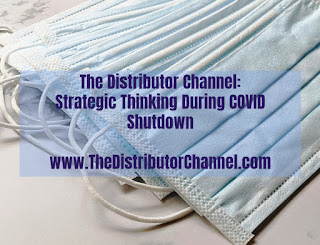Strategic Thinking during COVID Shutdown
Let’s review our current situation. Just about the time we were starting to get out and visit a few customers, the next wave, second wave, surge, or whatever they are calling it this week, has put salespeople back in their home office. Is this discouraging? You bet. And, based on my conversations with many of your customers, they are getting weary of the situation as well.
Salespeople continue to push forward.
Based on dozens of ongoing coaching sessions with sellers in our industry, today’s activities appear to follow a pattern. I have listed them in the order of reported time allocated:
1. Keeping in touch with our best customers by periodically calling them to see how things are going.
2. Follow-up on any incoming calls from customers.
3. Receiving calls from supplier sales types who are currently locked up and clamoring for information about specific customers and industry types.
4. Taking supplier calls about new products and attending yet another Zoom Meeting on the latest widget.
5. Finding some issue that warrants another phone call to a customer.
6. Reaching out to inactive customers in hopes of finding a problem to solve.
7. Sending personalized emails promoting new product releases from key suppliers.
8. Responding to any incoming emails from customers with a well-worded reply and offering additional services.
9. Over-investing time with customers still open to visits (when the local government allows).
Any kind of real planning shows up at about number 47 on this little “hit parade” of activities.
We could be stuck in this Corona-driven funk for a while longer
As we come up to the launch of another year, many distributors are starting to plan for 2021. The most optimistic of our colleagues are planning, hoping, wishing, or praying for a rapid hockey stick-shaped recovery. Lord knows I am right there with them. At the same time, mayors, governors, and other politicos are flipping the lever back to close-down mode. We could be in for more lockdowns through the remainder of the year. With this in mind, let’s take a moment to think strategically.
Thinking Strategically – What Accounts can provide the Fastest Growth?
When all of this is over, or at least starts diminishing, which accounts can provide you with the fastest growth? This might take a bit of thinking. Some types of businesses have a pent-up demand for your products, services, and solutions; they may hand over some nice orders. A few customers have necessary projects on hold because of the uncertainties tied to our pandemic situation. Both types of accounts present good future opportunities.
Are there accounts where you are positioned to expand your business? It could be you were on the cusp of a breakthrough right before our world took a downturn. Others are customers where you have built some momentum and see opportunities to displace competitors and expand your business.
Think about your personal list. Not every account will make it onto the list. Once a master list is completed, narrow it down to the best of the best; something like your five, six, or seven best prospects for growth.
This list will be the customers who fuel your growth.
We should assume this is a list comprised of good or maybe even your top accounts. To some, this seems counter-intuitive. They believe growth will come from a sea of new prospects just waiting for them to offer up their products and services. The truth is, doubling the size of a small $10 thousand customer does not produce the same results as gaining 10 percent growth at one of your larger accounts. Experts tell us selling more to an existing account is five times (5X) easier than selling to a new account. Why not go with the easiest first?
Create your list – We will call it our Growth Target List. The
best part of this is we can create the list now while we are couped up and be ready for later.Thinking Strategically – Who do you Know?
Think about this, if you know only one person at this account, you are a heart attack, or applying a dash of time-centric gallows humor, a COVID cell away from kissing the account good-bye. I am appalled by the number of distributor people whose relationships still revolve around their one “buddy” working in the engineering or maintenance department. And Lord help you if your pal is a member of the purchasing/procurement department.
Traditional wisdom dictates the following: To really build account momentum, a salesperson must know lots of people. While true, customer intimacy cannot be measured by the sheer number of contacts. Allow me to share a story about Barry:
Meet Barry
Barry is a sales guy. He takes great pride in his work. The number of people in his Outlook contact list is huge. At Barry’s biggest account, he knows all the storeroom clerks by name and when he brings donuts, he buys at least three dozen. One would think Barry is well entrenched and solid at the account; in many ways he is. The storeroom guys give Barry order after order and often ask him to supply the stuff sold by his competitors. He, in return, gives them stellar service by helping with inventory recommendations, identifying issues with product failures, steering warrant issues through the system, and lots of other things that make their jobs easier. Barry is living the sales dream, until…
One bright summer day, Barry learns his customer has decided to outsource the storeroom function. All his contacts are gone. The new company running the storerooms already has suppliers. Barry goes from champ to chump in 24 hours. Don’t be like Barry.
Who should Barry have known?
If Barry would have been in contact with upper management at his account, he would have been positioned to maintain the business. If he had been nurturing the relationship with solid middle managers in the company, he most likely would have received an early warning and taken steps to fix things. While our old buddy Barry knew the name of the person responsible for all the storeroom clerks, had shaken her had on a couple of occasions, and waved to her in the hallways, he had never invested in the relationship. Barry wishes he had.
With this sad tale in mind and the thoughts of what can happen if you don’t expand your reach inside your customers, let’s continue for a short review of the people you should know and maintain a relationship with on your Growth Target List.
Who should you know?
Knowing and having a relationship with the people at the top of every department provides a salesperson with a better picture of the customer's long-range plans. Referring back to our dawdling buddy Barry in the story, what would have happened if he knew at least the head of the department for the storeroom organization? He might have been asked if his organization could manage the storerooms; many distributors do that. Conversely, Barry might have been able to suggest a subcontractor more friendly to his company. This would have resulted in a big win for both Barry and a stronger ally in the business world.
I believe your list should look like this:
The Top Guy on Site – Depending on the company, this person might have the title of Owner, VP of Operations, Plant Manager, Division Manager, or something similar. They are the Big Kahuna. Nobody understands the future direction of the organization with the clarity they enjoy. They think in terms of dollars and business advantage. The details of your products bore the heck out of them, but if you talk about how you can provide greater productivity, more profits, or some other benefit, they will think you are a genius. One more point: Figuratively, these are the people who sign the check for your products and services. If they are buying a million dollars worth of your stuff, don’t you think they should know who you are?
Production Supervisors – Again, these positions are called by a million different names but they are the people responsible for the process of turning raw materials into products going out the door. In manufacturing, these people are incented by the number of units produced. In contracting, they are charged with getting the job done on time and under budget. Help them do a better job by solving a problem, and you’re “In like Flynn.” Seems like they would be good folks to know.
The Sales Team – If you call on an OEM or Machine Builder, I recommend you line up a conversation with their sales team. Because of the COVID situation and the inherent inability to travel, they should be easy to reach and just a phone call away. You have much in common with them so the conversation will be light and easy. Extending further, you have a common goal. If they sell more, your business will grow. Additionally, this group can provide you with feedback on what new product enhancements customers are asking for on your customers’ machines. This positions you to be ready to present to designers, engineers, and others working within the company. This is a cool thing.
Service Manager – Again, thinking of OEMs and Machine Builders, most companies provide some type of post-purchase warranty period. They know which products are failing or at least causing problems out in the field. Knowing this person may allow you to head off technology issues with your products and identify issues with competitive solutions; both could serve you well. Additionally, this person can provide some insight as to whether the customer sees spare parts sales as a nuisance or a profit center. Understanding this critical fact will help you drive future, and more profitable, spare part sales.
Director of Safety – Switching from OEMs to End User customers, the person charged with safety can be a great contact if you happen to sell machine guarding, light curtains, safety interlocks, crane hardware, or any of a dozen other products. Here’s what this person can do for you: Alert you to changes in the safety specifications, open doors to new safety-related applications, and, most importantly, give you an idea of the safety budget for the organization and priorities for projects.
With Barry in the Rear View Mirror
Just like you, Barry is working from home filling his days with phone calls and emails. Since he has been in this Corona-crap situation for an awfully long time, Barry is mostly out of anything new to say or do. In fact, his “howdy doodie” phone calls are starting to grate on his customers’ nerves. He is looking forward to the day the COVID Pandemic ends and he can get out there and shake hands with his customers. The real question is this: Will Barry’s business expand in the post-pandemic Era?
Barry has no Strategic Plan. Don’t be like Barry.
Want to build a better Strategic Plan? Consider reading
my book – Plan on Breaking Through: Customer-based Strategic Planning for Sellers.
 Frank Hurtte is the Founding Partner of River Heights Consulting. He combines the battle scars of 28 years of front line "in the trenches" experience with over 13 years of service to knowledge-based distributors and their manufacturer partners.
Frank Hurtte is the Founding Partner of River Heights Consulting. He combines the battle scars of 28 years of front line "in the trenches" experience with over 13 years of service to knowledge-based distributors and their manufacturer partners.
Email or call today to make these virus-driven times work for you.







Comments
car service center near me
Best car service in Bangalore
Visit: Employee Activity Monitoring Software